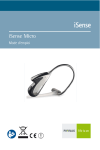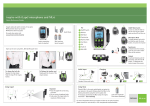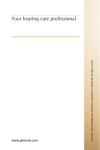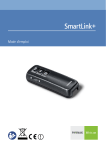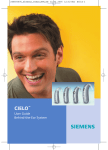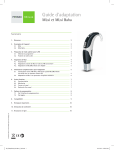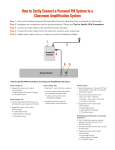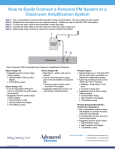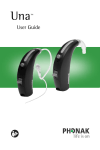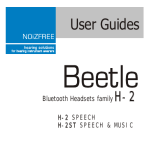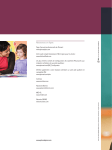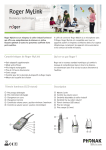Download You and us
Transcript
Life is on We are sensitive to the needs of everyone who depends on our knowledge, ideas and care. And by creatively challenging the limits of technology, we develop innovations that help people hear, understand and experience more of life’s rich soundscapes. You Interact freely. Communicate with confidence. Live without limit. Life is on. www.phonak.com 028-0257-02/V1.00/2007-11/FO Printed in Switzerland © Phonak AG All rights reserved and us Guide for parents and teachers You and us Dear parents and teachers Phonak has written this brochure to support you in raising and educating a hearing-impaired child. Your love and dedication are essential for children to grow, learn and develop socially and emotionally – in short: to give them the best start in life. Swiss-based Phonak is a leading manufacturer of hearing instruments. The company has globally recognized expertise in hearing solutions for children. Phonak is also synonymous with the world standard for wireless FM systems, the main focus of this booklet. Nine out of ten FM users use a Phonak FM system. Phonak technology will help your child hear and understand: the essentials for learning and development. The role of the hearing care professional lies in diagnosis and monitoring of the hearing loss or auditory processing disorder, and counseling in relation to it. Your professional has found that your child will benefit from a Phonak FM system, working with your child’s hearing instrument(s) or cochlear implant(s). If your child has an auditory processing disorder, the audiologist may have recommended EduLink. EduLink is an FM system that can help a child who does not use hearing instruments. 2000: first miniaturized universal FM receiver 2000: first design-integrated solution 2003: first miniaturized multifrequency receiver In 2000 Phonak developed the first miniaturized FM universal receiver: the MLx. “Universal” meant that the receiver could be connected to almost all brands of hearing instrument. This opened up wireless FM technology to almost all hearing-impaired children, no matter what brand of hearing instrument they were using. The MLx receiver could be connected to the hearing instrument with the help of a small connector called an audioshoe. All the major hearing instrument manufacturers then developed audioshoes for their hearing instruments that made connection to a Phonak MLx receiver possible. In 2000 the first FM receiver was developed that exactly matched the color, shape and design of the hearing instrument. This ML8 FM receiver made the Claro hearing instrument just a bit longer, and it was truly amazing how great it looked. In 2003 Phonak launched the first miniature multifrequency universal radio receiver, the MLxS. In the Phonak series of world firsts, this marked a big step on the way to flexibility. MicroLink receivers are little radios. The first series could only receive one frequency. In radio terms, it was like having only one station: it was not possible to change channels. For the first time, the MLxS allowed selection of different channels. This was especially helpful for children moving from one classroom to another. Teachers in schools each have their own FM frequency, like a personal radio station. A child can only hear the teacher when the receiver is at the right frequency. The MLxS could always be set to the teacher’s channel. This change of frequency was called “synchronization”. A clever device, the WallPilot, could even handle this frequency changing automatically. The WallPilot was hung next to the classroom door and any child entering the classroom was automatically tuned in to the frequency of the teacher in that classroom. This made educating hearing-impaired children so much easier and more flexible. Communication was seamless throughout the school. MLxS MicroMLxS Your role is crucial if the technology, prescribed by the hearing care professional, is to work in practice. This is where you and Phonak meet. FM systems require you to play a much more active role than you would with hearing instruments. We are going to explain why we offer this technology, what is so special about Phonak’s FM systems, and how you can use them to optimize your child’s prospects. Use this booklet in conjunction with the Phonak user guides for the inspiro transmitter, the FM receivers and the child’s hearing instruments or cochlear implants. 2000 Together we, you and your hearing care professional form a team. Our roles are different, but we share a common goal: to care for the children and to improve their quality of life through better hearing. MLx 4 ML8 with Claro 2007: first Dynamic FM system In 2006, the MLxS was succeeded by the MicroMLxS. The name actually stands for MicroMicroLink. This was really small: about half the volume of an MLxS and even smaller than a cashew nut. Their smaller size made these FM receivers popular among users of very small hearing instruments. At the same time, the sound quality was further improved: the sound of MicroMLxS was markedly more comfortable. Dynamic FM is Phonak’s latest great invention. It is a set of trailblazing breakthroughs which no expert ever considered possible. Dynamic FM marks a landslide improvement in speech understanding, especially in the noisiest conditions where – so far - even an FM system has not been enough. This feature sets Dynamic FM apart from all other FM systems. Dynamic FM makes fitting much easier for hearing care professionals. For teachers and parents, the inspiro transmitter offers a full menu on the color display, with many useful functionalities and support tools. The MLxi receiver is now the smallest receiver in the world. 2003 The ML10i design-integrated receiver for Phonak’s Naída Ultra Power hearing instrument is WaterResistant, like Naída itself. Together, Naída and the ML10i form the most powerful package of communication technology for hearing-impaired people. The microphones for inspiro are totally new designs. They combine elegance with wearing comfort and sound quality. Dynamic FM will be the global standard in FM technology for the coming years. 2007 inspiro MLxi MLxi with Naída ML10i with Naída You and us Dear parents and teachers Phonak has written this brochure to support you in raising and educating a hearing-impaired child. Your love and dedication are essential for children to grow, learn and develop socially and emotionally – in short: to give them the best start in life. Swiss-based Phonak is a leading manufacturer of hearing instruments. The company has globally recognized expertise in hearing solutions for children. Phonak is also synonymous with the world standard for wireless FM systems, the main focus of this booklet. Nine out of ten FM users use a Phonak FM system. Phonak technology will help your child hear and understand: the essentials for learning and development. The role of the hearing care professional lies in diagnosis and monitoring of the hearing loss or auditory processing disorder, and counseling in relation to it. Your professional has found that your child will benefit from a Phonak FM system, working with your child’s hearing instrument(s) or cochlear implant(s). If your child has an auditory processing disorder, the audiologist may have recommended EduLink. EduLink is an FM system that can help a child who does not use hearing instruments. Your role is crucial if the technology, prescribed by the hearing care professional, is to work in practice. This is where you and Phonak meet. FM systems require you to play a much more active role than you would with hearing instruments. We are going to explain why we offer this technology, what is so special about Phonak’s FM systems, and how you can use them to optimize your child’s prospects. Use this booklet in conjunction with the Phonak user guides for the inspiro transmitter, the FM receivers and the child’s hearing instruments or cochlear implants. Together we, you and your hearing care professional form a team. Our roles are different, but we share a common goal: to care for the children and to improve their quality of life through better hearing. 4 Phonak Maybe you would like to know a bit more about us. Phonak is a leading manufacturer of advanced hearing instruments. We believe that children with hearing impairment deserve nothing less than the best in hearing technology. Innovative output at Phonak is very high. Experience tells us that it is very difficult to design and build excellent hearing instruments. Today’s hearing instruments are packed with digital technology to improve the quality of sound and understanding of speech. Hundreds of engineers work daily at Phonak to devise ever-better solutions. Our leading-edge technology and our in-depth understanding of audiology, the science of hearing and hearing loss, have been the keys to our success. Phonak employs more than 4000 people worldwide. Our headquarters are in Switzerland, and we have subsidiaries and distributors in many countries round the globe. Hundreds of audiologists, engineers and scientists work at Phonak. They bring their clinical and scientific expertise, their personal commitment and their passion to our products and services, to help children hear better. 5 What is an FM system? An FM system is a wireless system that carries sound direct from source to ear. It consists of an FM microphone and one or two FM receivers. The FM microphone is actually a microphone connected to, or inside, a radio transmitter. The microphone picks up the desired signal (often your own voice). The transmitter then sends it on radio waves directly to the FM receiver. The FM receiver, in turn, is connected to the hearing instrument. The sound is delivered to the hearing instrument, the hearing instrument applies the right amplification and your voice can be heard as if you were talking from very close. There are also Phonak FM receivers for cochlear implants and bone-anchored hearing aids. However, the basic principle remains the same. 6 Why FM? The purpose of an FM system is to present the cleanest possible signal to the ear. Hearing-impaired children benefit tremendously from hearing instruments, but unfortunately, hearing loss is a very complicated condition. Even today’s most advanced hearing instruments cannot solve all the problems caused by hearing loss. When it comes to hearing speech in noisy places, over a distance or in the presence of echo (reverberation), it becomes progressively more difficult to understand what is being said. Hearing instruments cannot suppress enough noise to guarantee clear communication. dB 80 A Teacher’s voice 70 Background noise 60 B 50 40 0 1 2 4 6 Distance (meters) The teacher’s voice gets softer with increasing distance. Background noise is equally loud over the classroom and can reach levels of up to 65 dB and higher. It is important to realize that what is acceptable background noise for adults with normal hearing, may already deny a hearing-impaired child any chance of communication. Hearing loss almost always means that the noise barrier to communication is much more serious than we can imagine. The normal background noise in a living room or in a classroom already has a severe impact on speech understanding. The noise need not be loud to be detrimental. 8 Distance has the same negative impact on speech understanding as noise. While adults can easily follow a conversation over a distance of three to five meters (10 –15 feet), hearing-impaired children may already have considerable difficulties. And, even if they can understand every word spoken, it most likely costs them much more effort. An FM system cuts out the noise and bridges the distance: very important achievements. It makes speech understanding so much easier in many situations of communication which may seem normal to us, but pose a challenge to hearing-impaired children. Hundreds of scientific research projects and clinical experience with hundreds of thousands of hearing-impaired children round the world have demonstrated the outstanding benefits of FM systems. The improvement in speech understanding is remarkable. This leaves children less exhausted after a day in school and leads to improvements in their academic achievements and grades. FM systems are crucial to the development of the language and speech young children need in order to learn. In industrialized countries, FM systems for hearing-impaired children are considered part of a normal support program. All the leading pediatric hearing care professionals recommend FM systems. The reason is that FM is the best available technology to enhance speech understanding in acoustically challenging environments. Indeed, the number of FM systems used is increasing fast all over the world. There are places where technologies other than wireless FM are still in use. These may include induction loop systems. Although loop systems are also wireless, it must be remembered that they are a 19th-century technology. They are no longer part of present-day, evidence-based hearing health care for children. Studies and measurements have shown that induction systems drastically distort the sound and alter the loudness of the hearing instrument. The necessary use of T-coils in the hearing instruments allows loud and annoying interference. FM systems, which do not entail these serious audiological drawbacks, are therefore expected to replace loop systems everywhere. 9 How to use Dynamic FM at school or at home Your hearing care professional can advise on exactly when and how to use the Dynamic FM system in your specific situations. Here, we can give you some general recommendations. Take care of your FM system and treat it well. It will last longer. Basic tips on using the Dynamic FM system Use an FM system when the distance between you and the child is somewhat large than close range, when there is noise that you cannot turn off, or when there is considerable reverberation. In most classrooms, there is almost always too much noise for hearing-impaired children. Teacher-pupil distance is too great, and there is too much reverberation. But at home, too, in leisure time, in the backyard, at the mall, at sports venues and many other places and facilities, FM systems can be of tremendous benefit. With an FM system, your child will hear you as if you were speaking very clearly from a very short distance. This will make the speech signal very clean and clear. Before switching on the inspiro transmitter, fasten the microphone to your clothing (if you have an iLapel) or fit it to your ear (if you have an iBoom). Switch inspiro on. Your hearing care professional has probably already set your Dynamic FM receivers to the same frequency as your inspiro transmitter. After switching on inspiro, try not to touch the microphone to avoid amplified noise. If you need to rearrange the microphone, simply press the mute button on inspiro transmitter, and you can have a private conversation or reposition your microphone. Another press on the mute button will activate the microphone again. Do not use a different voice when you use inspiro. Speak normally – just as if you were not wearing an inspiro! 10 inspiro with iBoom inspiro with iLapel If you are using an iBoom, place the microphone around your ear and position the boom just left or right of your mouth. Make sure the ear loop is firm around your ear, but not too tight. The iBoom should stay more or less in place, even when you move your head, but it should also be very comfortable. If you are using an iLapel, make sure the iLapel is just below your chin, fastened to your clothing. The microphone cable should hang loose. This ensures that the directional microphones in the iLapel are pointing straight towards your mouth. 11 Do not use the Dynamic FM system as a walkie-talkie over long distances. The system is meant as a support in communication situations which adults with normal hearing would consider normal. It is not a bugging device. Whenever possible, turn your face towards the child. Children understand speech not only by listening. They learn the meanings of words, sentences and intonation through a combination of hearing and seeing. Charging inspiro The inspiro transmitter can be charged in one hour. Overcharging is impossible. If you use inspiro regularly, we suggest you connect the inspiro transmitter to the charger every night. A fully charged battery will last approximately 10 hours: this will get you through the day. If you have forgotten to charge inspiro, inspiro will warn you with a vibra alarm about 15 minutes before the battery is flat. inspiro is the only transmitter in the world with this feature. Monitoring We would advise you to monitor the FM receivers every day. Monitoring is a revolutionary and easy way of checking the functionality of the system. By pressing just one button on inspiro, inspiro reads out the status of the FM receivers. For this function to work properly, you need to hold inspiro within 40 cm (12 inches) of the receivers. The receivers must be connected to the hearing instruments, which need to be switched on. Check the inspiro display for any irregularities. This will give you the assurance that the system is working fine. With modern-day hearing instruments, the technology may be working perfectly with the hearing instruments in a program that does not transmit 12 the FM signal (an “M” program). Read the hearing instrument user manual or consult your hearing care professional to make sure you know how to set the hearing instruments to an FM program. It is also possible that only FM programs are programmed into the hearing instruments. Your hearing care professional will tell you if this is possible and desirable for your child. If the monitoring result requires you to take any action, the intelligent menu in the inspiro display will guide you to the solution. The visual indicators on the inspiro display are complemented by beeps which the child can hear. A system check is only complete if the child can hear the beeps. inspiro is the only FM system with such an advanced monitoring function. SoundCheck With inspiro, you can also carry out a SoundCheck. When you activate SoundCheck on the inspiro menu, the inspiro transmitter measures the noise level in the room. At the same time, it measures the loudness of your voice. Your voice may not be loud enough if the microphone is not positioned correctly or if you have a very quiet voice. This will show on the display. If there is too much noise in the room, indicated by a yellow or red bar in the display, try to improve the acoustics. If this is not possible, at least you know that, with so much noise present, the FM system will certainly help the child understand you better. But even if the room is quiet and your voice is loud enough, the child will still benefit tremendously from the Dynamic FM system. 13 Resources To find out more about Phonak’s FM systems, please ask your hearing care professional or visit the following websites: www.phonak.com This is the Phonak homepage. In the Consumer – Products section, click on “FM systems” to find out more about the wide range of FM products we offer. At www.phonak.com/consumer/parents.htm you will find a variety of information on hearing loss in children. www.eSchoolDesk.com This is a very special website dedicated to supporting teachers especially, but also parents, in their use of Phonak FM systems. Animations or movies explain many functions of the products in an easy-to-understand way. They show, for example, how to wear the transmitter correctly, how to charge or replace the battery and how to connect your transmitter to a TV set. www.FMeLibrary.com This is our online scientific library on FM systems. Here you can find published papers and reports on FM systems from all around the world. Access is free to all, and no registration is required. 15 Recommendations from your hearing care professional 16 Your personal notes 17 What Dynamic FM users say In summer 2007, a first group of hearing-impaired children and adults were able to test the first prototype Dynamic FM products for a week. They compared the new system with conventional FM systems. Scientific measurements showed that speech understanding in noisy surroundings was far better than with conventional FM systems. This was underlined by the test users’ comments: “It had a good sound on it and it was easier to hear anybody else talk” “In a noisy situation the difference was pretty significant” “I could really hear the difference between the voice and the background noise” “I tried it at home, in the car, and at the aquarium. I liked the new system better” “I heard pretty good with it!” “I liked it!” “If I had this in school, it would help me a lot more” “It was really good!” 18 The history of auditory trainers and FM systems 1968: bodyworn FM systems 1996: MicroLink: first miniaturized FM receiver The first FM systems for hearing-impaired people appeared in 1968. They consisted of large, bodyworn units, with a great number of cables. Today we would consider them antique. They were not user-friendly, not suitable for children, teachers or parents, but they were the only solution available at the time. Of course, the same audiological principles applied then as today: the best solution has always been a wireless connection between the source of the sound and the ear. Success was limited in the early days, mainly because the systems were ill-adapted to daily use and the technology was new, even to the professionals. In the 1980s leading visionaries at Phonak realized that FM systems needed to be smaller and user-friendly if they were to take off. Clearly, there was a dream-like quality about developing radio receivers as small as a cashew nut, with high sound quality and low battery consumption! Though the task was not easy, Phonak embarked on this mission to develop the world’s first miniature FM receiver, the MicroLink. In 1992 Phonak even set up a special company in this field, in Switzerland. It took leading engineers four years to develop the first MicroLink. In 1996, the ML3 (MicroLink 3) was presented at a hearing instrument conference in Germany: a revolutionary breakthrough in the history of hearing systems. The ML3 was the world's smallest radio receiver, and it simply plugged into the Phonak hearing instrument. Now “wireless” really did mean wireless. 1968 1996 Bodyworn FM system from 1974 ML3




















